

Data journalism training – some reflections. I recently spent 2 days teaching the basics of data journalism to trainee journalists on a broadsheet newspaper.

It’s a pretty intensive course that follows a path I’ve explored here previously – from finding data and interrogating it to visualizing it and mashing – and I wanted to record the results. My approach was both practical and conceptual. Conceptually, the trainees need to be able to understand and communicate with people from other disciplines, such as designers putting together an infographic, or programmers, statisticians and researchers. Area graph: meat consumption. Hacks/Hackers » Journalism x Technology. Many Eyes. Flowing Data Tutorials. Data Reporting. For Journalism. A flow chart and some technical solutions for data journalists, via @paulbradshaw of the Online Journalism Blog.
Amnon P5 - Experiments with Processing by Amnon Owed. 25 life-saving tips for Processing Posted by Amnon on January 28, 2012 · 37 Comments Well, perhaps they won’t literally save your life.
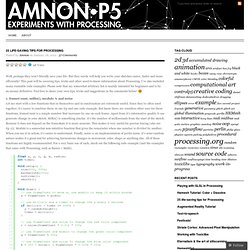
But they surely will help you write your sketches easier, faster and more efficiently! This post will be covering tips, tricks and other need-to-know information about Processing. I’ve also included many runnable code examples. 1. frameCount, millis(), modulo % and noise Let me start with a few functions that in themselves and in combination are extremely useful. 2. math, logical and relational operator shortcuts Any program will use operators. 3. math with ints A very common mistake is doing math operations on integers and expecting a floating number outcome. 4. frameRate Processing’s frameRate is by default capped at 60 fps. 5. loading specific files from an external input directory Many applications use file input, for example an image or a data file.
Data journalism for beginners. Data-driven journalism. Data-driven journalism, often shortened to "ddj", is a term in use since 2009/2010, to describe a journalistic process based on analyzing and filtering large data sets for the purpose of creating a news story.

Main drivers for this process are newly available resources such as "open source" software and "open data". This approach to journalism builds on older practices, most notably on CAR (acronym for "computer-assisted reporting") a label used mainly in the US for decades. Other labels for partially similar approaches are "precision journalism", based on a book by Philipp Meyer, published in 1972, where he advocated the use of techniques from social sciences in researching stories. Data-driven journalism has an even wider approach. As projects like the MP Expense Scandal (2009) and the 2013 release of the "Offshore leaks" demonstrate, data-driven journalism can assume an investigative role, dealing with "not-so open" aka secret data on occasion.
Definitions[edit] Jesse James Garrett: Visual Vocabulary for Information Architecture. Looking for more?
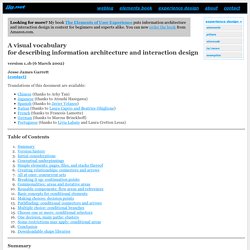
My book The Elements of User Experience puts information architecture and interaction design in context for beginners and experts alike. You can now order the book from Amazon.com. version 1.1b (6 March 2002) Jesse James Garrett (contact) Infographic: Reading for the Future. This content was produced by GOOD with the support of Apollo Group Being able to read is one of the most important skills a person can have, and a child's reading level in third grade gives a good indication of their future success.

Why third grade? It's a pivotal point in a child's education where they go from learning to read to reading to learn. Take a look at the infographic to see how reading proficiency impacts a child's life, and what parents and teachers can do to ensure children are reading on grade level. Presented by Apollo Group, Teaching for Tomorrow explores education, innovation and technology in schools through original videos and infographics. Information Design – isabelmeirelles.com. Course description:The course introduces basic concepts, methods and procedures of information design with focus on mapping information.
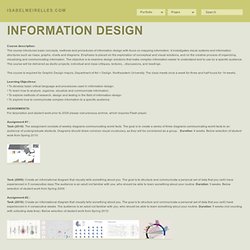
It investigates visual systems and information structures such as maps, graphs, charts and diagrams. Emphasis is placed on the exploration of conceptual and visual solutions, and on the creative process of organizing, visualizing and communicating information. The objective is to examine design solutions that make complex information easier to understand and to use by a specific audience. The course will be delivered as studio projects, individual and class critiques, lectures, –discussions, and readings.
The course is required for Graphic Design majors, Department of Art + Design, Northeastern University. ASSIGNMENTS: For description and student work prior to 2009 please visit previous archive, which requires Flash player. Assignment #1 :Task (2010): The assignment consists of weekly diagrams communicating world facts. Data Science. The inverted pyramid of data journalism. I’ve been working for some time on picking apart the many processes which make up what we call data journalism.
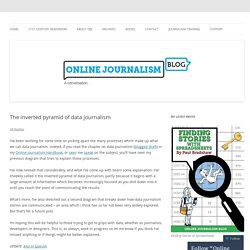
Indeed, if you read the chapter on data journalism (blogged draft) in my Online Journalism Handbook, or seen me speak on the subject, you’ll have seen my previous diagram that tries to explain those processes. I’ve now revised that considerably, and what I’ve come up with bears some explanation. I’ve cheekily called it the inverted pyramid of data journalism, partly because it begins with a large amount of information which becomes increasingly focused as you drill down into it until you reach the point of communicating the results. What’s more, I’ve also sketched out a second diagram that breaks down how data journalism stories are communicated – an area which I think has so far not been very widely explored. But that’s for a future post. How to be a data journalist.
Data journalism is huge.
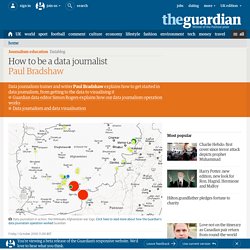
I don't mean 'huge' as in fashionable - although it has become that in recent months - but 'huge' as in 'incomprehensibly enormous'. It represents the convergence of a number of fields which are significant in their own right - from investigative research and statistics to design and programming. The idea of combining those skills to tell important stories is powerful - but also intimidating. Who can do all that? The reality is that almost no one is doing all of that, but there are enough different parts of the puzzle for people to easily get involved in, and go from there. 1. How to Start a Blog - A Complete Guide to Setting up a Blog. Journalism in the Age of Data: A Video Report on Data Visualization by Geoff McGhee.
How to: get to grips with data journalism. A graph showing the number of IEDs cleared from the Afghanistan War Logs Only a couple of years ago, the idea that journalists would need to know how to use a spreadsheet would have been laughed out of the newsroom.
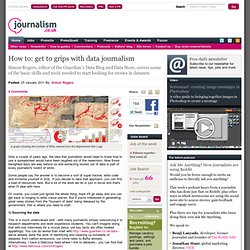
Now those benighted days are way behind us and extracting stories out of data is part of every journalist's toolkit of skills. Some people say the answer is to become a sort of super hacker, write code and immerse yourself in SQL. If you decide to take that approach, you can find a load of resources here. 22 free tools for data visualization and analysis. You may not think you've got much in common with an investigative journalist or an academic medical researcher.

But if you're trying to extract useful information from an ever-increasing inflow of data, you'll likely find visualization useful -- whether it's to show patterns or trends with graphics instead of mountains of text, or to try to explain complex issues to a nontechnical audience. There are many tools around to help turn data into graphics, but they can carry hefty price tags.
The cost can make sense for professionals whose primary job is to find meaning in mountains of information, but you might not be able to justify such an expense if you or your users only need a graphics application from time to time, or if your budget for new tools is somewhat limited. Learning How To Visualize. Been getting a ton of requests for ‘how to’s and guides for creating decent visualizations and information designs.
Made me think: maybe I could do some workshops in this area. I like developing ideas and working with people. Could be fun! So if you think you’d like to attend a workshop on visualization or organize one for your organisation, please fill in this quick form (30 seconds). In the meantime, you might be interested in a section I’ve been building in a far-flung corner of the site.
Perscription Drug Project. The central platform for crowdsourcing US Government challenges, contests, competitions and open innovation prizes. Visualization. Processing. Statistics Help for Journalists. Numbers can't "talk," but they can tell you as much as your human sources can. But as with human sources, you have to ask! So what should you ask a number? Well, mathematicians have developed an entire field — statistics — dedicated to getting answers out of numbers. Now, you don't have to have a degree in statistics in order to conduct an effective "interview" with your data. But you do need to know a few basics. In 1996, I first published Statistics Every Writer Should Know, an online tutorial for math-phobic journalists.
Running a business demands at least a basic knowledge of math and math concepts, so I'm including this tutorial as an appendix my 2012 book, How to Make Money Publishing Community News Online. Here, described in plain English, are some basic concepts in statistics that every writer should know... So, You're a Beginner? Mean Let's get started... Median How to find out how the "average Joe" is doing Mode So, like, who's popular? Percent Ch-ch-ch-changes... Journalism, code and data. Welcome. List of data journalism tools. Datajournalismelab. Free web tools to build infographics. Data journalism.